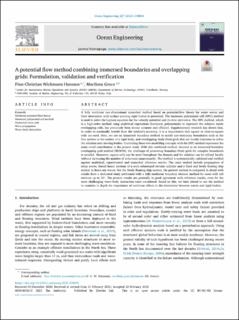| dc.contributor.author | Hanssen, Finn Christian W. | |
| dc.contributor.author | Greco, Marilena | |
| dc.date.accessioned | 2021-03-29T11:16:59Z | |
| dc.date.available | 2021-03-29T11:16:59Z | |
| dc.date.created | 2021-03-26T15:14:21Z | |
| dc.date.issued | 2021 | |
| dc.identifier.citation | Ocean Engineering. 2021, 227 . | en_US |
| dc.identifier.issn | 0029-8018 | |
| dc.identifier.uri | https://hdl.handle.net/11250/2735950 | |
| dc.description.abstract | A fully nonlinear two-dimensional numerical method based on potential-flow theory for water waves and their interaction with surface-piercing rigid bodies is presented. The harmonic polynomial cell (HPC) method is used to solve the Laplace equation for the velocity potential and its time derivative. The HPC method, which is a high-order method using analytical expressions (harmonic polynomials) to represent the solution inside overlapping cells, has previously been shown accurate and efficient. Supplementary research has shown that, in order to maximally benefit from the method’s accuracy, it is a requirement that square or close-to-square cells are used. Here, we use an immersed boundary method to model non-stationary boundaries such as the free surface or the surface of a rigid body, and overlapping, body-fixed grids that are locally Cartesian to refine the solution near moving bodies. Combining these two modelling concepts with the HPC method represents the main novel contribution in the present work. With this combined method, denoted as an immersed-boundary overlapping grid method (IBOGM), the challenge of generating boundary-fitted grids for complex boundaries is avoided. Moreover, square cells can be used throughout the domain and the solution can be refined locally without increasing the number of unknowns unnecessarily. The method is systematically validated and verified against analytical, experimental and numerical reference results. The cases studied include propagation of steep waves, forced heave motions of a semi-submerged circular cylinder and a fixed and freely floating ship section in beam-sea waves. For the freely floating ship section, the present method is compared in detail with results from a dedicated study performed with a fully nonlinear boundary element method for cases with roll motions up to 30◦ . The present results are generally in good agreement with reference results, even for the most challenging wave–body interaction cases considered. Based on this, we later intend to use the method to examine in depth the importance of nonlinear effects in the interaction between waves and rigid bodies. | en_US |
| dc.language.iso | eng | en_US |
| dc.publisher | Elsevier | en_US |
| dc.rights | Attribution-NonCommercial-NoDerivatives 4.0 Internasjonal | * |
| dc.rights.uri | http://creativecommons.org/licenses/by-nc-nd/4.0/deed.no | * |
| dc.title | A Potential Flow Method Combining Immersed Boundaries and Overlapping Grids: Formulation, Validation and Verification | en_US |
| dc.type | Peer reviewed | en_US |
| dc.type | Journal article | en_US |
| dc.description.version | publishedVersion | en_US |
| dc.source.pagenumber | 23 | en_US |
| dc.source.volume | 227 | en_US |
| dc.source.journal | Ocean Engineering | en_US |
| dc.identifier.doi | https://doi.org/10.1016/j.oceaneng.2021.108841 | |
| dc.identifier.cristin | 1901383 | |
| dc.description.localcode | © 2021 The Author(s). Published by Elsevier Ltd. This is an open access article under the CC BY-NC-ND license. | en_US |
| cristin.ispublished | false | |
| cristin.fulltext | original | |
| cristin.qualitycode | 1 | |

